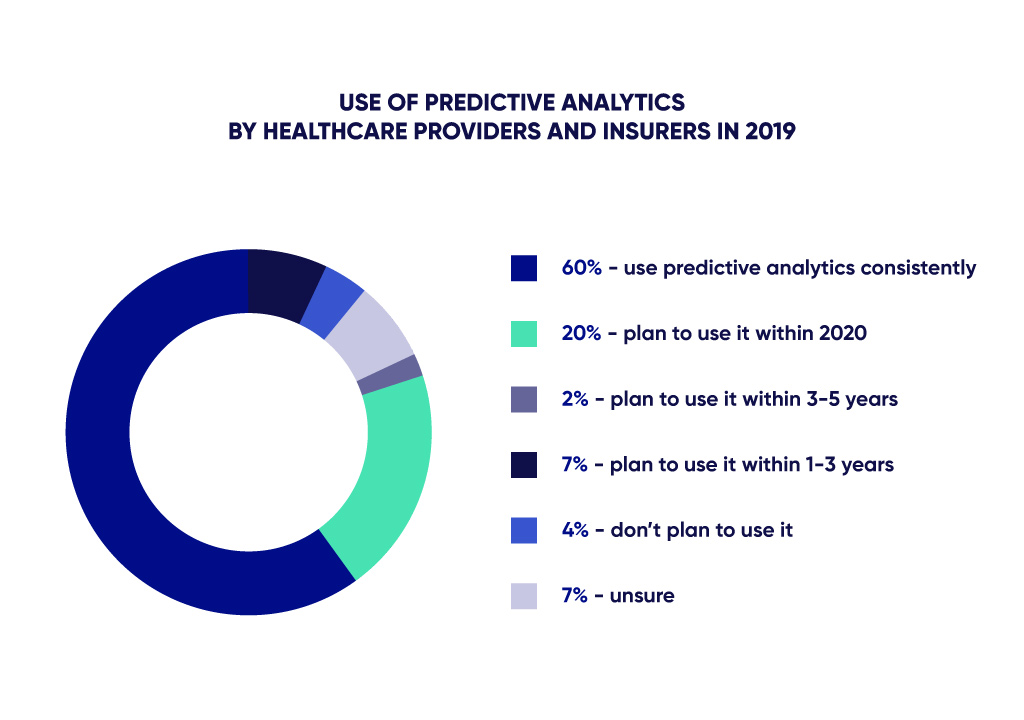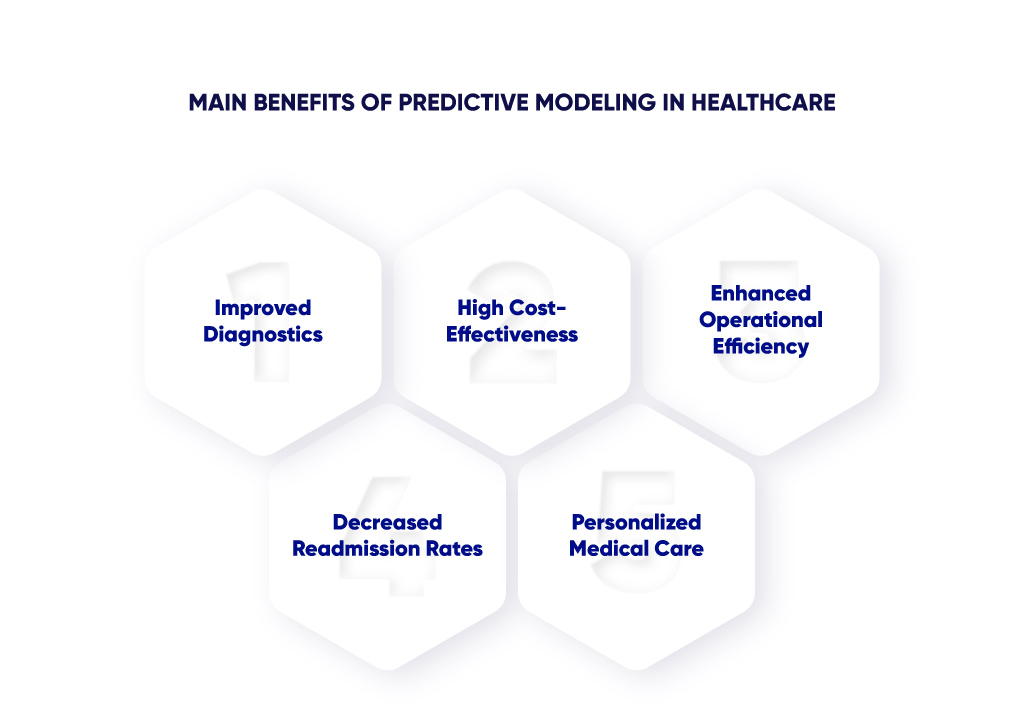Healthcare companies are always under high pressure because of the numerous risks that the medical industry has to deal with every day. The implementation of high-accuracy predictive technologies allows them to put this pressure down by eliminating mistakes that, in the worst scenario, can cost human lives. Besides, predictive modeling provides ways for healthcare organizations to improve both public and personal medical care.
The global crisis of 2020 has shown that the industry needs predictive solutions more than ever to become able to prevent outbreaks of dangerous diseases throughout the world. This article will help you learn more about predictive modeling in healthcare, examples of its usage, benefits, and the most popular predictive modeling techniques.
What Is Predictive Modeling in Healthcare?
Predictive modeling in healthcare (sometimes called predictive analytics) deals with statistical methods, data mining, and game theory to analyze current and historical data collected at the medical establishment. This kind of data collection and thorough analysis help to an extent, forecast future events, improve patient care, and ensure favorable health outcomes both for the facility’s patients and the general public. Based on medical record information, age, social and economic characteristics, individual anatomy, and many other factors, predictive analysis can reveal patients’ susceptibility to such diseases as diabetes, asthma, and other lifestyle-related conditions. Using this kind of information, a healthcare professional can tailor the treatment plan accordingly and continue to track the patient’s condition to achieve the best possible care results in the long run.
When building a predictive model, data mining and data analytics are used for finding similar patterns in behavior and forecasting people’s responses or actions to occurring events. The world’s largest medical organizations are on their way to integrating advanced practices such as predictive analysis, simulation, and variable modeling. The end goal of using different predictive modeling techniques is the optimization of decision-making, problem-solving, identifying opportunities for improving the health system and finding a reliable way to predict future outcomes in healthcare. Some examples of predictive models that are currently widely used by healthcare market players are:
- Classification model — is a machine learning model that tries to forecast a specific class label for a certain input data example. In a nutshell, the classification model helps to receive answers to simple yes/no questions.
- Neural network — this machine learning algorithm is inspired by the structure and the functioning of a human brain. It is the most suited for handling more complex tasks (e.g., pattern recognition or decision-making). Typically, a neural network is used in combination with other predictive modeling techniques in order to receive the most accurate and reliable forecasts.
- Gradient boosted model — a method using multiple decision trees to produce a stronger, more accurate predictive model.
- Generalized linear model — a statistical modeling framework that accommodates a broad range of data distributions and relationships between variables. GLM is known for its flexibility and is usually applied where the assumptions of regular linear regression may not be appropriate.
- Clustering model — an unsupervised machine learning model that divides instances of data points into different groups (clusters) based on defined similarities.
- Forecast model — a model used to predict future values based on historical data. Forecast models aim to capture patterns within said data to make predictions about future trends.
- Outlier model — a machine learning model designed specifically for identifying aberrant observations in a dataset. Unlike a clustering model focusing more on similarities, an outliers model finds deviations, which is a perfect basis for fraud detection.
Now that you’re familiar not only with the predictive modeling definition but also with the most common predictive modeling tools, let’s dive into real-life usage examples and perks of this technology for healthcare providers.
Predictive Tools Usage Statistics
One of the most prominent cases of using predictive analytics was Parkland Health & Hospital System. In 2009, Parkland started analyzing electronic medical records to decrease readmission rates of patients suffering from congestive heart failure. Shortly after that, the hospital began applying the models forecasting high readmission risk in patients with diagnosed pneumonia, diabetes, and heart attack.
In 2019, the Society of Actuaries (SOA) presented the report on predictive analytics in healthcare to figure out healthcare providers’ expectations for the future. The results showed that 60% of respondents were already using predictive tools and predictive modeling techniques in their systems to improve KPIs in hospitals, clinics, and health insurance companies. 20% had planned to implement prognostic models within 2020.

In 2020, the demand for forecasting technology increased as a response to the global crisis. It increased so much so that in 2032 global predictive analytics tools market size, specifically in healthcare, is expected to reach an outstanding USD 54.87 billion.
Moreover, in 2023 25% of health systems and medical services providers have already reported utilizing artificial intelligence and machine learning predictive modeling as short-term priorities for risk stratification.
The next part of this article will contain information about the most popular use cases of predictive analytics in healthcare. Examples we’ve included are gathered from different fields of medicine to illustrate the versatility and overall advantageousness of predictive modelling better.
Examples of Using Predictive Modeling Techniques in Medicine
There are diverse applications of predictive models at hospitals and healthcare companies, but we will highlight the five most important of them at this stage of medical science development. Our list covers the health insurance field and other branches of medicine that currently rely on predictive analytics models the most.
Health Insurance
Predictive modeling in health insurance allows service providers to calculate the accurate cost of insurance for a specific individual. It is possible to define how reasonable it would be to provide a particular medical insurance plan to the applicant, considering such parameters as insurance case history, age, gender, region, medical history, heredity, bad habits, and other historical data. When performed correctly, predictive modeling is able to identify potentially fraudulent behavior and optimize risk levels, help the provider improve relations with policyholders, especially those who are thinking about switching to another insurance company, accelerate claims processing, and offer many other benefits, which we’ll cover later in this article.
Medical Imaging
Radiology is another field that shows the high efficiency of artificial intelligence and machine learning models. One of the most prominent examples here is the University of Montreal Hospital Centre. It uses the AI solution that notices anatomical changes in individual patients and identifies disease-specific markers based on X-ray photographs. This solution also helps to prepare patients for surgical interventions based on predictive analytics models.
The use of prognostic software in radiology is especially relevant in lung screening and breast cancer diagnostics. X-rays data is used to predict the patient's exposure to viral diseases affecting the lungs and help doctors focus primarily on the most vulnerable patient categories. Prognostic models and Digital Breast Tomosynthesis (DBT) provide the full picture of breast anatomy and allow detection of breast diseases early.
Palliative Care
Penn Medicine is one of the most reputed academic medical centers that use predictive models based on electronic health records (EHR). These predictive modeling algorithms let doctors forecast health risks for patients with life-threatening diseases. A model named Palliative Connect is based on 30 factors for predicting patient status and future outcomes. Palliative Connect can make predictions about a patient for the next six months after admission to the hospital. The machine learning algorithms help doctors focus on people with a high risk of mortality to improve palliative consultations and the overall quality of care. The Penn Medicine research aims to achieve favorable patient outcomes and reduce the death rate of the population.
Mental Health
According to WHO, almost 800,000 people end their lives by suicide, and over 20 million make self-kill attempts every year. Numerous factors cause most people to suffer from chronic stress, the worst outcomes of which can be severe depression, self-aggression, and suicide. To keep people mentally healthy and at least decrease the negative influence of information overload on a modern human, various medical organizations and scientists implement predictive solutions based on EHR and mental health visits of a specific patient.
The prediction-based system analyzes data on both people who have committed suicide and living patients. This way, predictive models may not only identify people at high risk of committing or attempting suicide but also prevent undesirable future events keeping patients from self-harm. As a result, it is possible to provide these people with timely support through helper applications and qualified therapists, thus significantly reducing the percentage of self-oriented agression around the world.
Pharmacy Services
The pharmaceutical industry is one of the first to adapt to changes caused by fierce competition between such companies on the market. Pharmacies mostly use predictive modeling to optimize marketing and sales. They help to forecast medication demand, customer churn, the next purchases of a particular patient, and consumer preferences.
However, in some cases, even the most demanded drug can be ineffective for a particular person. Therefore, the pharmacists’ goal is to use relevant data and predictive analysis to provide the necessary medication to the right patients at the right time. For this purpose, pharmaceutical companies rely on EHR data and new clinical data demonstrating the efficacy of a particular drug in curing atypical forms of well-known diseases.
Another way of incorporating different predictive analytics algorithms in the pharmaceutical business is the drug discovery and development process. Data modeling simplifies target identification, pharmacokinetics and pharmacodynamics estimation, as well as compound screening. Predictive analytics algorithms help carefully analyze historical data, biological data, and emerging new data, optimize dosing regimens, understand disease pathways, predict future outcomes for newly developed drugs, and cut the development time, which can usually take up to a decade.
Benefits of Predictive Modeling in Healthcare
The medical industry owes its fast development to digital transformation, which has provided numerous advantages for healthcare providers, doctors, and patients. In this part, we will describe the benefits that healthcare predictive analytics opens for healthcare providers.

Improved Diagnostics
Some diseases have typical symptoms, and qualified doctors can easily define them and cure them according to the predefined treatment plan. However, each patient can have individual or, so to say, atypical symptoms that might point at a specific disease, but make diagnostics more complicated. The presence of atypical symptoms makes specialists rely on individual patient data and family history to define whether a person needs hospitalization to cure a disease. Laboratory testing and diagnostic procedures like CT, X-rays, MRI, etc., combined with predictive analytics, have more value for further diagnosis and treatment plan choice. Even the most common predictive algorithms and predictive techniques may provide a completely different outlook on diagnostics, automatically identifying and presenting hidden patterns that could be previously missed or unseen by the medical staff.
High Cost-Effectiveness
One of the essential reasons why healthcare organizations choose to implement predictive analytics is the ability to reduce costs significantly. With a great amount of existing data on patients, staff, equipment, supplies, administrative tasks, and scheduling, one can generate detailed information on managing costs and patient risks. Based on this information, it becomes clear what technical and organizational barriers a facility currently faces and what expenses you can cut without sacrificing anything important.
Supply management is one of the complex processes requiring considerable expenses. Predictions about patient conditions, staffing, devices, contractors, etc. can reduce the number of suppliers for the same items. They can also help you save money by urging doctors to use more economical equipment and avoid miscarriages and poor management within the supply chain.
Enhanced Operational Efficiency
When overloaded, hospitals face medical staff shortages that often severely affect the quality of patient care. By implementing predictive models, your organization can allocate administrative resources and management to know about staffing challenges in advance. In this case, a software specialist can build a predictive model following the analysis of such predictors as the number of medical personnel available, seasonal changes affecting population health, holidays, outbreaks, etc.
Medical organizations can also manage skipped appointments and adjust patient flow for better capacity planning in the most convenient way for doctors and patients. Specialists can include current data on patients who frequently fail to show up and provide notice about skipping appointments in advance to predict gaps in doctors’ schedules and adjust them more efficiently, thus eliminating time waste.
Decreased Readmission Rates
The readmission rate is a factor indicating the quality of care provided at a particular hospital. According to the applicable regulations in many European countries and throughout the US, hospitals must pay the penalty for patient readmissions in case of disease relapse. When patients readmit to the hospital 30 days after their initial admission with the same complaints, it indicates that the treatment wasn't efficient enough the first time. Predictive models help your organization prevent readmission from happening by calculating the readmission probability during the first patient’s assessment, based on current and historical data. It’s fair to say that readmission is still possible even once the facility management chooses to adopt predictive analytics in healthcare. However, the rates will most definitely drop down upon the predictive modelling incorporation.
Personalized Medical Care
Healthcare institutions tend to increase their efficiency by using the opportunities of precision medicine. Predictive modeling helps to improve patient-centered care based on personal health records and contributes to the creation of the most effective treatment plans tailored for each patient aimed to achieve the best possible future outcomes. Prognostic models are exceptionally efficient for inpatient and emergency treatment when fast decisions have to be made, and external factors play a major role in how future events will turn out. Any available data at the organization allows to precisely predict the effectiveness of procedures, manipulations, laboratory tests, and medications depending on the specifics of a person's anatomy and genes.
Main Techniques
Predictive modeling includes several stages that involve the usage of specific techniques. These techniques let data science experts work with forecasting models in the most efficient way for the healthcare business. Some of the most notable are:
- Data Cleansing. The stage of predictive modeling during which specialists refine data from outliers to prepare only necessary data for modeling.
- Logistic regression. A statistical technique that aims to define parameters of a logistic model based on the previous examination of datasets.
- Decision trees. This predictive modeling technique allows the creation of tree-like graphs that show map relationships between items and the potential consequences of the predicted events.
- Time series analysis. This stage includes analyzing data assets as they change over time to deliver valuable predictions of future trends within the indicated time period.
Final Thoughts
Predictive analytics has the most significant positive impact on businesses that operate massive amounts of data, face numerous risks, and quickly adapt to market changes. The healthcare industry is one of such market niches. Medical companies often work under pressure, considering a great deal of responsibility to improve the health of millions of people. Advanced technologies like predictive modeling are the key to making their work much more efficient and bearable. Data scientists at our company use big data, artificial intelligence, data analytics, data mining, and machine learning to build advanced predictive modeling solutions for businesses.
Now that you know exactly what is predictive modeling and how it can be beneficial for your business case, don’t hesitate to contact us. Light IT Global has dozens of custom healthcare projects under its belt, and our experts are always ready to create unique software that will bring you measurable value.




